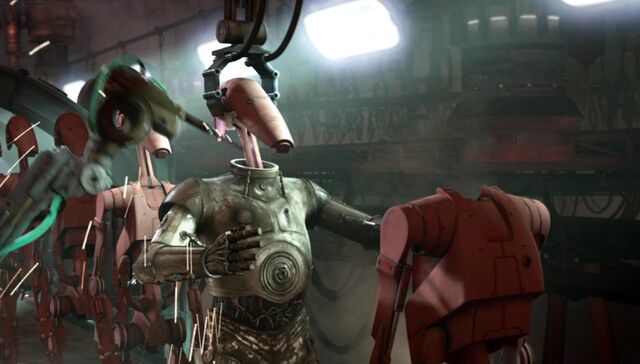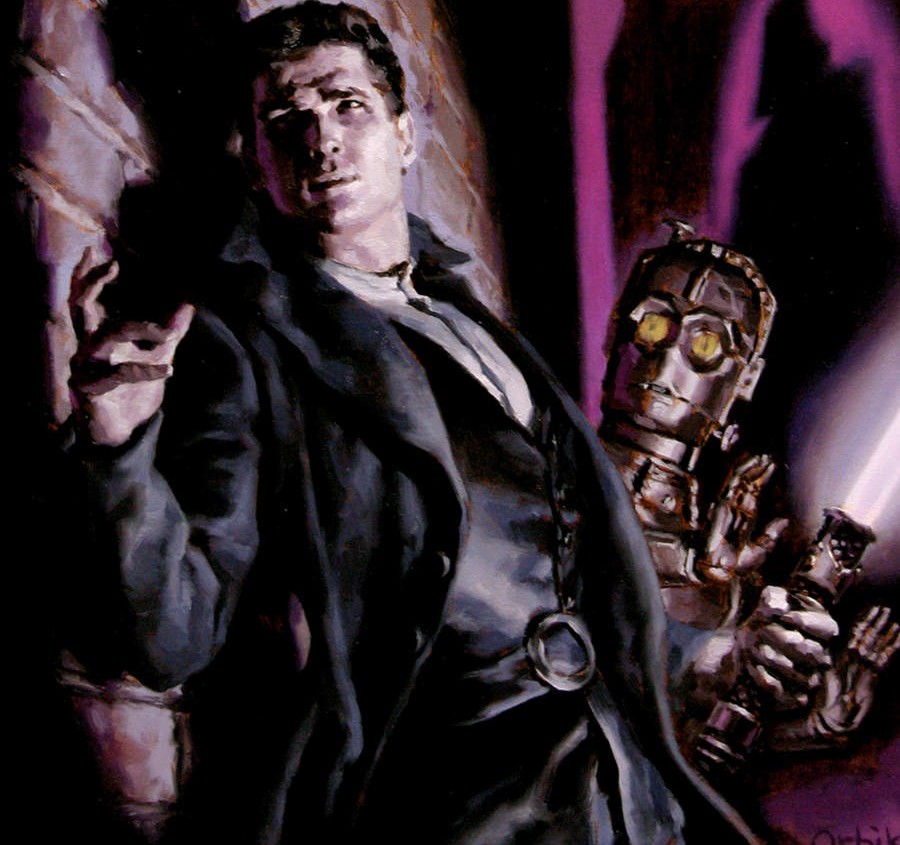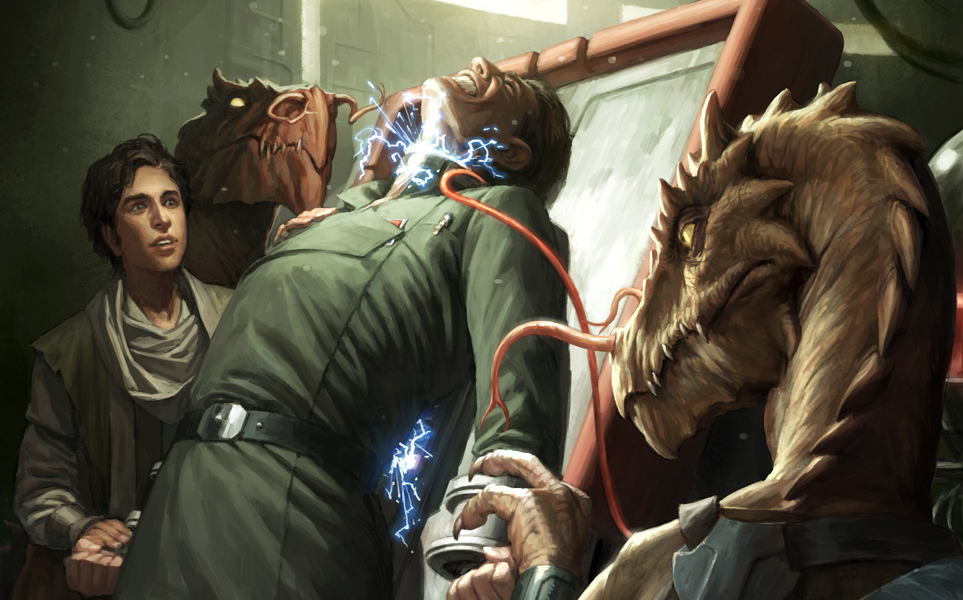
“He’s more machine, now, than man; twisted and evil.” — Obi-Wan Kenobi.
“Oh my.” — See-Threepio.
Are droids in Star Wars sentient? Well, we don’t know. And I’m not here to tell you. Sure, I could pull out my New Essential Guide to Droids or Tales of the Bounty Hunters, and discuss whether it was a narrative crime not to include Vuffi Raa in the New Jedi Order, but that would mainly illustrate a broader point: why is this question almost exclusively dealt with in secondary sources? Is Star Wars even interested in answering this question?
A popular theory might be that Star Wars is space fantasy rather than science fiction, and as such the staunchly science fictional tradition of artificial intelligence would break the mythic iconography of a fairy tale in the stars. I’d argue that Pinocchio could just as easily be See-Threepio and that it’s not that Star Wars hasn’t integrated the traditional tale of the Golem into its canon, it’s that it chooses to give it to clones rather than battle droids.
The Phantom Menace needed to establish villains a PG-rated movie would be comfortable slicing up with laser swords in their hundreds – it needed zombies, or monsters. Non-people. The stylistic trappings of a futuristic universe made robots an obvious choice. Threepio and Artoo, on the other hand, fill a very different narrative role and remind me of nothing so much as those magical animals in Disney movies. Those part-comic relief, part-best-friend, part-pet, part-plot-MacGuffin, often sent-by-a-fairy-godparent-with-important-messages, not-quite-people. Droids are magical helpers. Droids are familiars. If this were pure fantasy, Artoo-Detoo might well be Puck. Mechanizing the role is, once again, an easy way to adhere to the decor of the Star Wars universe, but slapping “droid” on both the comedy sidekicks and the faceless minions implies a commonality I don’t actually think is there. The similarities are cosmetic. Thinking of Threepio and Artoo as soulless is, well, soulless, but the movies clearly invite us not to think about battle droids as anything other than automata.
Perhaps I’m also starting to sound a little soulless – deconstructing stories can be destructive; what’s the use in a pile of parts with no whole to measure against? So I should probably note why I think this is important: Darth Vader. Star Wars has a grand tradition of incorporating technology into its mythic imagery. The transhumanist in me might want to criticize the apparent binary of man vs machine, but I can’t criticize the deftness of Vader’s corrupted relationship to the Force of life itself represented in the replacement of his body with inorganic, unalive, machinery. Of Luke’s replacement hand, miraculous in its lifelike mimicry, but ultimately a symbol of his possible fate, should he follow his father’s path.

Is this why most of the mainstream Star Wars stories, either movie or Expanded Universe, imply a droid’s level of sentience through narrative function but tend to avoid specific discussion?
On a basic thematic level, this fictional universe defines machinery in opposition to the Force. Whether or not it’s sentient, if it’s not a part of the Force, can we ever say that a droid is alive? And is this universe more concerned with life than sentience? Even the Yuuzhan Vong were ultimately found to have a connection to the Force as living creatures, while droids still appear to function as objects no different than rocks or cups of caf. Would foregrounding the story of a sentient, truly living droid unavoidably challenge the thematic authority of the Force? To be more blunt: would it just feel wrong?
Or perhaps we should examine this from a more practical perspective. What would happen if we insisted on a definitive answer? It’s easy to construct an argument that if they are independent, thinking beings, then the galaxy far, far away relies on ubiquitous slavery. But what about the reverse? If we were to say that no droid is truly aware and that any expression of personality or preference is the result of programming designed to put organic end-users at ease? It’s certainly possible to construct an argument that this is damaging because it could be seen as a reflection of the dehumanization strategies used throughout our real, live, actual history. But would it also be creepy in a purely diegetic context?
Does viewing our favourite odd-couple tramping through the sand on Tatooine, bickering about directions and getting kidnapped by Jawas work if we don’t think of them as “people”? Without the role of the comedy sidekick protecting them from our robotic expectations, would they drift nearer to the corrupting, untrustworthy image of Darth Vader?

I’m not so sure this is the leap it appears to be. If we concern ourselves with their machine natures first and foremost, then questions such as reprogrammability, emotion and ethics become unavoidable and obvious narrative hooks. Particularly in a world which has such a deliberate construction of the machine as an assault on the spirit, from Vader to Luke to Grievous.
But I’m asking a lot of questions here, and I think maybe we can find some answers. Droid stories don’t tend to get top billing, but there are plenty if you know where to look. The trick is finding tales that actively engage with questions of sapience and autonomy.
I-5YQ
I-5 was created by Michael Reeves and first appeared in Darth Maul: Shadow Hunter, and subsequently appeared in two other series by the same author – MedStar (co-authored with Steve Perry), and Coruscant Nights. His character arc continues throughout the various series, and is one of the most developed droid characters the Expanded Universe has to offer. Issues of sentience, sapience and servitude are all addressed.
However, I’d note that the series in which he appears – primarily MedStar and Coruscant Nights, break tonally with the expected genre of space fantasy. MedStar clearly owes much to the gallows humour of M.A.S.H. and Coruscant Nights evokes detective noir. Both are more suited to handle the nihilism of a droid’s search for recognition and inebriation.
IG-88
IG-88, on the other hand, hails from the famed Empire bounty hunter line-up and, as is tradition, the Expanded Universe has left no movie character unexplored, no matter how short the screen-time. Rather than seeking to mimic humanity, IG-88 embraces his droid nature, creating copies of himself and planning revolution for his kind.
Here we have an unambiguous threat. IG-88’s story embraces the sinister machine imagery already present in the original movies. In fact, by refusing to seek identity on humanistic terms, the character may even align himself with the pure war machinery of the Empire – the imposing bow of a Star Destroyer, the whine of a TIE, or, of course, the Death Star he almost succeeded in commandeering.
Entechment
The Ssi-ruuvi process of transferring organic consciousness into a machine. Droids with minds created in such a fashion (or at least, successfully created, as Nichos Marr, our next subject, was a failure in such an experiment) would be in a unique position to argue parity of experiential existence. And yet, the technology is presented as an abomination, entirely in keeping with the grotesquerie of Vader’s body.
Nichos Marr
A character we only ever met as a pale imitation of a former living being, Nichos is an example of what happens when droids are unambiguously confirmed to be no more than programming. Cray Mingla is caught in a relationship with a ghost, and while the tragedy and self-delusion are no doubt magnified by her romance with the original Nichos, I believe a similar sad pathos would colour any friendship that was revealed to exist solely for the benefit of the living participant.
A cautionary tale against prodding too deeply at what goes on inside Artoo’s mind?
So, what’s my point? That Star Wars engages philosophically with technological themes in areas other than artificial intelligence? To the (broad) exclusion of artificial intelligence? Well, yes. Sort of. I certainly think it would be foolish to approach Episode VII expecting Skywalker vs Skynet.
But I think there’s a more interesting point to be made here about context. The original movie trilogy borrowed deeply from the war movies of the previous generation. Lucas even substituted WWII movie footage into a rough cut of the film in place of the unfinished special effects during the space dogfights. They might sound British but the Empire are quite clearly Nazi analogues, and with that comes the spectre of technological superiority, the image of an uncompromising, unyielding, mechanical war machine rolling across Europe, or in this case, Space, with no one capable of opposing it.

In contrast the prequel trilogy is all smooth lines and clean computer interfaces. Pristine CGI fills every background window – Coruscant is unambiguously futuristic and beautiful. The events are there: the loss of Anakin’s arm, Obi-Wan ending Grievous’ quest for mechanical perfection by shooting his last remaining organ, the uniform lines of combat droids… But somehow the tone is less oppressive and I can’t help but speculate that for all the original trilogy featured the cutting edge special effects of its day, it made a conscious effort to recall that bygone era of tank battles and dogfights in a way the prequels do not.
At the risk of venturing into realms of pure speculation, the exponential technological development in our society means that even the ten years between the release of Episode III and Episode VII may prove tonally cavernous. In 2005, there was no Twitter. Facebook was barely a year old. Tablet computing would not gain any real traction for another half-decade. We left our computers at home and cell phones were still used for, well, phone calls. We may not be implanting speakers directly into our ears for a while, but our increasing integration with technology does make me wonder if our fear of the cyborg will be as resonant?
Will Episode VII follow the example of the originals and deliberately set about creating a specifically retro tone and style? Or will it follow the prequels’ more modern conceptions of futuristic technology – sleek, beautiful and, well, organic?
These things are not irreconcilable; I’d cite Man of Steel and Prometheus as two recent science fiction movies that establish beautiful, seductive technological visuals only to clearly establish them as potentially malignant. But in a fictional universe where “space fantasy” is so often used to excuse it from the concerns of “science fiction”, I think its treatment of technology is actually a crucial, if subterranean, part of its identity. These movies merge mechanics and mysticism. Your robot is a supernatural guide and your laser sword reflects your soul.
“An elegant weapon for a more civilized age.” — Obi-Wan Kenobi.


One thought to “Programmable Souls: On Droids and Narrative”
Comments are closed.